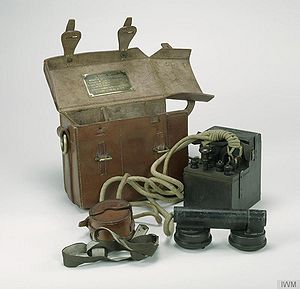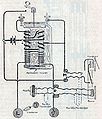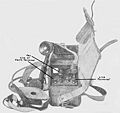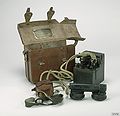Telephone Set D Mk III
| Telephone D Mk III | |
|---|---|
 |
The Telephone Set D Mk III and the Mk III* differed only in the method of anchoring the handset and extra receiver. In the D Mk III they were anchored to a Cord Jib while in the D Mk III* they were anchored to a bracket under the L or E terminal.
During the Great War it was found that "earth return" phones made it possible for the enemy to overhear. In an effort to prevent this, earthed circuits in the forward area were replaced with two wires (later twisted pair). Even with that, information might still be given away through badly insulated and otherwise defective circuits. In particular, it was soon found that the earth plate in the "D3" telephone was a source of leakage, and orders were issued that "D3s" were to be kept in their cases while in use and that future issues should have the earth-plate disconnected as a precaution.[2] These latter phones appear to have been marked to differentiate them from the earlier type.
General Description[3]
The complete telephone consists of a metal instrument case together with a hand-set (compoorising a receiver, a microphone, and a microphone switch), and a separate head receiver. The instrument case is divided into two compartments. One compartment contains two "S" or "X" type cells to the to the terminals of which metal strips are connected. These strips make contact with corresponding metal strips fixed to the sides of the cell compartments, and thence connections are made with the internal circuits of the instrument. The other compartment contains the buzzer, and on the lid of this compartment are fitted the key, the line and earth terminals, the flexible leads to the hand-set and head receiver. In addition, in the base off this compartment a fixed condenser is fitter which is connected to a special line terminal on the lid marker CL. The CL terminal must be used if it is necessary to "tee-in" to a line on which a direct current is being used to operate an instrument such as a telegraph sounder.
The telephone is carried in a leather case. This case comprises two compartments, a lid and carrying strap. The instrument is packed in the case as follows:--
The metal instrument case is placed in the larger of the two compartments (with it's back against the leather partition) by means of the cloth carrying strap which is fixed to the sides of the instrument. The hand-set and separate head receiver leads must not be twisted.
The telescoping hand-set is closed and its flexible lead is wound lengthways round the receiver and microphone. The separate head reciever is then placed against the microphone of the hand set and the two are placed into the smaller of the two leather compartments.
The flexible lead of the separate head receiver is then placed neatly into the recess thus left above this receiver. The leather lid is closed and fastened.
Related Pages
Related Items
References
- ↑ Signal Training Volume III. Pamphlet No. 1. Telephone Sets, D, Mark III*. 1926.
- ↑ The Signal Service in the European War of 1914 to 1918 – Chapter 6
- ↑ Signal Training (All Arms) 1932








